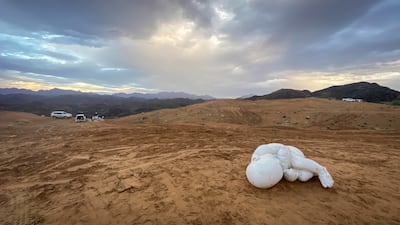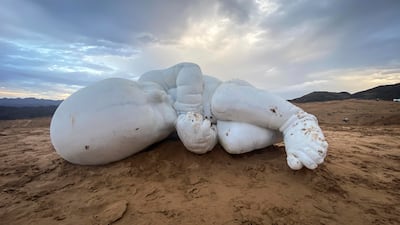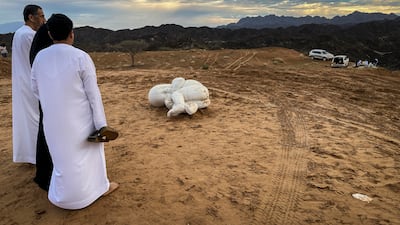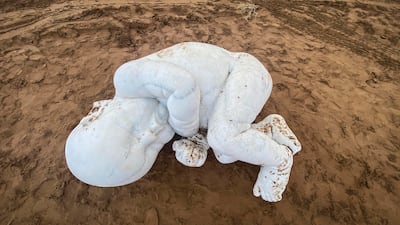25°22’08.6”N 56°02’57.7”E.
These are the co-ordinates to an “abandoned” infant sculpture that suddenly appeared in Fujairah at the end of last year.
Carved from white marble, the baby is curled up as if in slumber, its eyes closed and lips turned down. It is laid out, exposed to the elements, on the bare ground, surrounded by the rocky Fujairah mountains. Over the weeks, visitors have made the trek to seek out the sculpture – its location remains tricky to pinpoint despite the help of maps – after seeing it on social media.
Jago, the artist behind the work, first conceived of it in 2019 while he was living in New York City. “I saw a lot of homeless people living in the streets. When you have to run around every day to go to work, at some point, those people just disappear and become part of the environment. But I think the image of a baby will push us to stop and do something,” he tells The National.
That same year, he returned to Italy, and it wasn’t until 2020, after Covid-19 struck, that the sculpture was realised. Seeing the effects of lockdown on the vulnerable and the poor, including the homeless, Jago returned to the idea of an infant, a figure that easily connotes vulnerability and helplessness. Within eight months, he made Look Down (a play on “lockdown”), a baby in fetal position with a chain cuffed to its wrist.
In his works, the sculptor, who was born in Italy, draws from personal reflection, but uses recognisable figures and motifs to express his ideas. With clay and marble as his materials of choice, he moulds and carves sculptures that have a hint of the grotesque, from models of anatomical hearts to ghostly figures shrouded in cloth, and even a baby nestled inside the cracked skull of a male bust.
Look Down rested in the Piazza del Plebiscito, a public square in Naples, where the artist resides. It was installed in late 2020, as Italy was tightening its restrictions again owing to the second wave of Covid-19 in Europe.
People touched it, and also destroyed it in some ways, so the sculpture changed
Jago,
artist
Part of the artist’s intention was not only to capture the attention of passers-by, but also to allow viewers to consider what they might have grown to overlook over time and the sections of society that the pandemic has hit the hardest.
Over the course of six months, public interaction with Look Down grew. “When you ‘abandon’ something on the street, it’s not yours anymore. You have to accept that everyone can use or interact with the sculpture in different ways. People touched it, and also destroyed it in some ways, so the sculpture changed. It’s like having a child that eventually has to live in the world and be affected by it,” he says.
When restrictions finally eased, Jago removed the sculpture from the plaza and began thinking about another place for the work. This time, he wanted a location that was more distant and harder to reach.
He thought back to his trip in Fujairah years ago. “It’s a very particular place because you can find mountains and the desert together. You have the sea, mountains and desert, but the sands don’t change as much, because the mountains protect it from the wind,” he says.
Co-ordinating with the Fujairah government, the artist was able to install his work at the base of the mountains of Al Haniyah desert, where it is meant to stay until March before being moved to a permanent location that will be revealed later on. Exposed to wind, rain and sun, the sculpture will eventually be altered and blemished, but the artist says he now sees these changes as part of the work.
With its new location, the work also earned a new name, Look Here. This time around, the artist sought a place that would be less accessible, so that the act of seeing the infant would become more intentional, deliberate.
“If you leave something in the desert and someone spends time and energy to go see it, to take a picture, it means a lot. For someone to do that means that he recognises something about himself in the work, in the image. There’s a connection,” he explains.
There is one significant change to the work from its previous iteration in Naples: the chain is gone. The artist, however, did not comment on the reason behind this decision except to say, “sometimes things happen and we have to accept it”.
Jago, however, says the message of the work remains the same: to compel the public to think about the most vulnerable among us and to cultivate a response of care as we would towards a child. But he also hopes the experience of finding and seeing Look Here among the mountains opens up the public’s imagination and outlook on the world.
“Humanity is curious. Humanity wants to participate and see something new. This is a primordial part of us. When we’re babies, we have something very powerful, we have curiosity and enthusiasm, but as we grow, we lose that. But we need it in our work, our lives. This is our power."
Mercer, the investment consulting arm of US services company Marsh & McLennan, expects its wealth division to at least double its assets under management (AUM) in the Middle East as wealth in the region continues to grow despite economic headwinds, a company official said.
Mercer Wealth, which globally has $160 billion in AUM, plans to boost its AUM in the region to $2-$3bn in the next 2-3 years from the present $1bn, said Yasir AbuShaban, a Dubai-based principal with Mercer Wealth.
“Within the next two to three years, we are looking at reaching $2 to $3 billion as a conservative estimate and we do see an opportunity to do so,” said Mr AbuShaban.
Mercer does not directly make investments, but allocates clients’ money they have discretion to, to professional asset managers. They also provide advice to clients.
“We have buying power. We can negotiate on their (client’s) behalf with asset managers to provide them lower fees than they otherwise would have to get on their own,” he added.
Mercer Wealth’s clients include sovereign wealth funds, family offices, and insurance companies among others.
From its office in Dubai, Mercer also looks after Africa, India and Turkey, where they also see opportunity for growth.
Wealth creation in Middle East and Africa (MEA) grew 8.5 per cent to $8.1 trillion last year from $7.5tn in 2015, higher than last year’s global average of 6 per cent and the second-highest growth in a region after Asia-Pacific which grew 9.9 per cent, according to consultancy Boston Consulting Group (BCG). In the region, where wealth grew just 1.9 per cent in 2015 compared with 2014, a pickup in oil prices has helped in wealth generation.
BCG is forecasting MEA wealth will rise to $12tn by 2021, growing at an annual average of 8 per cent.
Drivers of wealth generation in the region will be split evenly between new wealth creation and growth of performance of existing assets, according to BCG.
Another general trend in the region is clients’ looking for a comprehensive approach to investing, according to Mr AbuShaban.
“Institutional investors or some of the families are seeing a slowdown in the available capital they have to invest and in that sense they are looking at optimizing the way they manage their portfolios and making sure they are not investing haphazardly and different parts of their investment are working together,” said Mr AbuShaban.
Some clients also have a higher appetite for risk, given the low interest-rate environment that does not provide enough yield for some institutional investors. These clients are keen to invest in illiquid assets, such as private equity and infrastructure.
“What we have seen is a desire for higher returns in what has been a low-return environment specifically in various fixed income or bonds,” he said.
“In this environment, we have seen a de facto increase in the risk that clients are taking in things like illiquid investments, private equity investments, infrastructure and private debt, those kind of investments were higher illiquidity results in incrementally higher returns.”
The Abu Dhabi Investment Authority, one of the largest sovereign wealth funds, said in its 2016 report that has gradually increased its exposure in direct private equity and private credit transactions, mainly in Asian markets and especially in China and India. The authority’s private equity department focused on structured equities owing to “their defensive characteristics.”
The%20Super%20Mario%20Bros%20Movie
%3Cp%3E%3Cstrong%3EDirectors%3A%3C%2Fstrong%3E%20Aaron%20Horvath%20and%20Michael%20Jelenic%0D%3Cbr%3E%3Cstrong%3EStars%3A%3C%2Fstrong%3E%20Chris%20Pratt%2C%20Anya%20Taylor-Joy%2C%20Charlie%20Day%2C%20Jack%20Black%2C%20Seth%20Rogen%20and%20Keegan-Michael%20Key%0D%3Cbr%3E%3Cstrong%3ERating%3A%3C%2Fstrong%3E%201%2F5%3C%2Fp%3E%0A
UAE-based players
Goodlands Riders: Jamshaid Butt, Ali Abid, JD Mahesh, Vibhor Shahi, Faizan Asif, Nadeem Rahim
Rose Hill Warriors: Faraz Sheikh, Ashok Kumar, Thabreez Ali, Janaka Chathuranga, Muzammil Afridi, Ameer Hamza
The President's Cake
Director: Hasan Hadi
Starring: Baneen Ahmad Nayyef, Waheed Thabet Khreibat, Sajad Mohamad Qasem
Rating: 4/5
EMERGENCY PHONE NUMBERS
Estijaba – 8001717 – number to call to request coronavirus testing
Ministry of Health and Prevention – 80011111
Dubai Health Authority – 800342 – The number to book a free video or voice consultation with a doctor or connect to a local health centre
Emirates airline – 600555555
Etihad Airways – 600555666
Ambulance – 998
Knowledge and Human Development Authority – 8005432 ext. 4 for Covid-19 queries
WITHIN%20SAND
%3Cp%3EDirector%3A%20Moe%20Alatawi%3C%2Fp%3E%0A%3Cp%3EStarring%3A%20Ra%E2%80%99ed%20Alshammari%2C%20Adwa%20Fahd%2C%20Muhand%20Alsaleh%3C%2Fp%3E%0A%3Cp%3ERating%3A%203%2F5%3C%2Fp%3E%0A
Scoreline
Man Utd 2 Pogba 27', Martial 49'
Everton 1 Sigurdsson 77'
Company%20profile
%3Cp%3E%3Cstrong%3ECompany%20name%3A%20%3C%2Fstrong%3EHakbah%0D%3Cbr%3E%3Cstrong%3EStarted%3A%20%3C%2Fstrong%3E2018%0D%3Cbr%3E%3Cstrong%3EFounder%3A%20%3C%2Fstrong%3ENaif%20AbuSaida%0D%3Cbr%3E%3Cstrong%3EBased%3A%20%3C%2Fstrong%3ESaudi%20Arabia%0D%3Cbr%3E%3Cstrong%3ESector%3A%20%3C%2Fstrong%3EFinTech%0D%3Cbr%3E%3Cstrong%3ECurrent%20number%20of%20staff%3A%20%3C%2Fstrong%3E22%20%0D%3Cbr%3E%3Cstrong%3EInitial%20investment%3A%20%3C%2Fstrong%3E%24200%2C000%0D%3Cbr%3E%3Cstrong%3EInvestment%20stage%3A%20%3C%2Fstrong%3Epre-Series%20A%0D%3Cbr%3E%3Cstrong%3EInvestors%3A%20%3C%2Fstrong%3EGlobal%20Ventures%20and%20Aditum%20Investment%20Management%0D%3Cbr%3E%3Cbr%3E%3C%2Fp%3E%0A
The Transfiguration
Director: Michael O’Shea
Starring: Eric Ruffin, Chloe Levine
Three stars
How to watch Ireland v Pakistan in UAE
When: The one-off Test starts on Friday, May 11
What time: Each day’s play is scheduled to start at 2pm UAE time.
TV: The match will be broadcast on OSN Sports Cricket HD. Subscribers to the channel can also stream the action live on OSN Play.
UAE currency: the story behind the money in your pockets
Left Bank: Art, Passion and Rebirth of Paris 1940-1950
Agnes Poirer, Bloomsbury
The Vile
Starring: Bdoor Mohammad, Jasem Alkharraz, Iman Tarik, Sarah Taibah
Director: Majid Al Ansari
Rating: 4/5
Fifa%20World%20Cup%20Qatar%202022%20
%3Cp%3E%3Cstrong%3EFirst%20match%3A%20%3C%2Fstrong%3ENovember%2020%0D%3Cbr%3E%3Cstrong%3EFinal%2016%20round%3A%20%3C%2Fstrong%3EDecember%203%20to%206%0D%3Cbr%3E%3Cstrong%3EQuarter-finals%3A%20%3C%2Fstrong%3EDecember%209%20and%2010%0D%3Cbr%3E%3Cstrong%3ESemi-finals%3A%20%3C%2Fstrong%3EDecember%2013%20and%2014%0D%3Cbr%3E%3Cstrong%3EFinal%3A%20%3C%2Fstrong%3EDecember%2018%3C%2Fp%3E%0A
The specs
Engine: 3.0-litre 6-cyl turbo
Power: 435hp at 5,900rpm
Torque: 520Nm at 1,800-5,500rpm
Transmission: 9-speed auto
Price: from Dh498,542
On sale: now
Normcore explained
Something of a fashion anomaly, normcore is essentially a celebration of the unremarkable. The term was first popularised by an article in New York magazine in 2014 and has been dubbed “ugly”, “bland’ and "anti-style" by fashion writers. It’s hallmarks are comfort, a lack of pretentiousness and neutrality – it is a trend for those who would rather not stand out from the crowd. For the most part, the style is unisex, favouring loose silhouettes, thrift-shop threads, baseball caps and boyish trainers. It is important to note that normcore is not synonymous with cheapness or low quality; there are high-fashion brands, including Parisian label Vetements, that specialise in this style. Embraced by fashion-forward street-style stars around the globe, it’s uptake in the UAE has been relatively slow.
US%20federal%20gun%20reform%20since%20Sandy%20Hook
%3Cp%3E-%20April%2017%2C%202013%3A%20A%20bipartisan-drafted%20bill%20to%20expand%20background%20checks%20and%20ban%20assault%20weapons%20fails%20in%20the%20Senate.%3C%2Fp%3E%0A%3Cp%3E-%20July%202015%3A%20Bill%20to%20require%20background%20checks%20for%20all%20gun%20sales%20is%20introduced%20in%20House%20of%20Representatives.%20It%20is%20not%20brought%20to%20a%20vote.%3C%2Fp%3E%0A%3Cp%3E-%20June%2012%2C%202016%3A%20Orlando%20shooting.%20Barack%20Obama%20calls%20on%20Congress%20to%20renew%20law%20prohibiting%20sale%20of%20assault-style%20weapons%20and%20high-capacity%20magazines.%3C%2Fp%3E%0A%3Cp%3E-%20October%201%2C%202017%3A%20Las%20Vegas%20shooting.%20US%20lawmakers%20call%20for%20banning%20bump-fire%20stocks%2C%20and%20some%20renew%20call%20for%20assault%20weapons%20ban.%3C%2Fp%3E%0A%3Cp%3E-%20February%2014%2C%202018%3A%20Seventeen%20pupils%20are%20killed%20and%2017%20are%20wounded%20during%20a%20mass%20shooting%20in%20Parkland%2C%20Florida.%3C%2Fp%3E%0A%3Cp%3E-%20December%2018%2C%202018%3A%20Donald%20Trump%20announces%20a%20ban%20on%20bump-fire%20stocks.%3C%2Fp%3E%0A%3Cp%3E-%20August%202019%3A%20US%20House%20passes%20law%20expanding%20background%20checks.%20It%20is%20not%20brought%20to%20a%20vote%20in%20the%20Senate.%3C%2Fp%3E%0A%3Cp%3E-%20April%2011%2C%202022%3A%20Joe%20Biden%20announces%20measures%20to%20crack%20down%20on%20hard-to-trace%20'ghost%20guns'.%3C%2Fp%3E%0A%3Cp%3E-%20May%2024%2C%202022%3A%20Nineteen%20children%20and%20two%20teachers%20are%20killed%20at%20an%20elementary%20school%20in%20Uvalde%2C%20Texas.%3C%2Fp%3E%0A%3Cp%3E-%20June%2025%2C%202022%3A%20Joe%20Biden%20signs%20into%20law%20the%20first%20federal%20gun-control%20bill%20in%20decades.%3C%2Fp%3E%0A
Sunday's games
All times UAE:
Tottenham Hotspur v Crystal Palace, 4pm
Manchester City v Arsenal, 6.15pm
Everton v Watford, 8.30pm
Chelsea v Manchester United, 8.30pm
Smart words at Make Smart Cool
Make Smart Cool is not your usual festival. Dubbed “edutainment” by organisers Najahi Events, Make Smart Cool aims to inspire its youthful target audience through a mix of interactive presentation by social media influencers and a concert finale featuring Example with DJ Wire. Here are some of the speakers sharing their inspiration and experiences on the night.
Prince Ea
With his social media videos accumulating more half a billion views, the American motivational speaker is hot on the college circuit in the US, with talks that focus on the many ways to generate passion and motivation when it comes to learning.
Khalid Al Ameri
The Emirati columnist and presenter is much loved by local youth, with writings and presentations about education, entrepreneurship and family balance. His lectures on career and personal development are sought after by the education and business sector.
Ben Ouattara
Born to an Ivorian father and German mother, the Dubai-based fitness instructor and motivational speaker is all about conquering fears and insecurities. His talk focuses on the need to gain emotional and physical fitness when facing life’s challenges. As well managing his film production company, Ouattara is one of the official ambassadors of Dubai Expo2020.
MATCH INFO
Uefa Champions League semi-finals, first leg
Liverpool v Roma
When: April 24, 10.45pm kick-off (UAE)
Where: Anfield, Liverpool
Live: BeIN Sports HD
Second leg: May 2, Stadio Olimpico, Rome
How the bonus system works
The two riders are among several riders in the UAE to receive the top payment of £10,000 under the Thank You Fund of £16 million (Dh80m), which was announced in conjunction with Deliveroo's £8 billion (Dh40bn) stock market listing earlier this year.
The £10,000 (Dh50,000) payment is made to those riders who have completed the highest number of orders in each market.
There are also riders who will receive payments of £1,000 (Dh5,000) and £500 (Dh2,500).
All riders who have worked with Deliveroo for at least one year and completed 2,000 orders will receive £200 (Dh1,000), the company said when it announced the scheme.
RESULT
Argentina 0 Croatia 3
Croatia: Rebic (53'), Modric (80'), Rakitic (90' 1)
Stamp duty timeline
December 2014: Former UK finance minister George Osbourne reforms stamp duty, replacing the slab system with a blended rate scheme, with the top rate increasing to 12 per cent from 10 per cent:
Up to £125,000 - 0%; £125,000 to £250,000 – 2%; £250,000 to £925,000 – 5%; £925,000 to £1.5m: 10%; Over £1.5m – 12%
April 2016: New 3% surcharge applied to any buy-to-let properties or additional homes purchased.
July 2020: Rishi Sunak unveils SDLT holiday, with no tax to pay on the first £500,000, with buyers saving up to £15,000.
March 2021: Mr Sunak decides the fate of SDLT holiday at his March 3 budget, with expectations he will extend the perk unti June.
April 2021: 2% SDLT surcharge added to property transactions made by overseas buyers.







